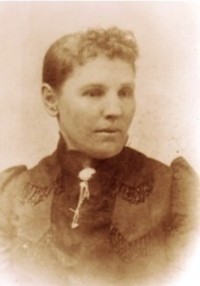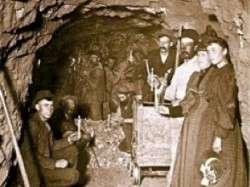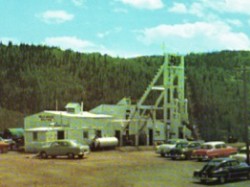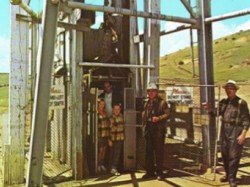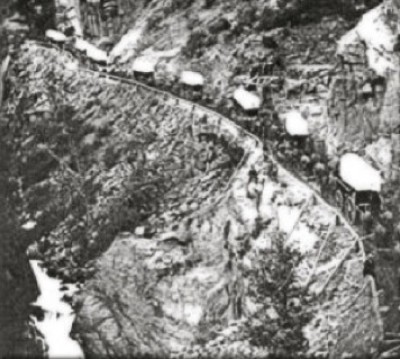The Story of Mollie & Her Famous Gold Mine
As handed down by descendants of Mary Catherine Gortner
& The National Geological Survey
Coming West to Colorado from Ottumwa, Iowa, arriving with her husband Henry, son Perry and daughter Elizabeth, the Gortner family first settled on North Nevada Street in Colorado Springs.
In the spring of 1891 Mollie’s son Perry arrived in the Cripple Creek area employed as a surveyor assigned to map mining claims of this country’s newest and overlooked frontier. With all news of the day focused on Cripple Creek’s gold. Mollie loaded the family wagon with supplies and joined the next wagon train heading west up Ute Pass to visit her son. After a four day trip, Mollie was relieved to find Perry had completed construction of a half log half canvas field tent. Mollie wasted little time setting up housekeeping.
In September of that year (1891), Perry while surveying upper Poverty Gulch, saw a huge herd of elk. Later he told Mollie of the herd so she headed out to see for herself. As she made her way up Poverty Gulch (three hundred yards past Cripple Creek’s first gold strike--- Bob Womack’s Gold King Mine---,) winded Mollie decided to rest.
Looking downward,as she caught her breath, Mollie noticed an interesting rock formation that winked back at her. Using a rock to break off a sample, she could hardly believe her eyes, the outcropping was pure gold laced in quartz.
With her heart racing Mollie nonchalantly hid gold samples amongst her clothing, she had to be calm, there were a number of prospectors in the area. Earlier that day Mollie had mingled with Bob Womack whom had overlooked her find for more than a dozen years prospecting an area he had nicknamed Poverty Gulch.
By her determined act, Mollie Kathleen Gortner became the first woman in the Gold Camp to discover gold and strike a claim in her own name. This was clearly a bold move out of step with the times. Most men of the time, only named their horses, jack asses, and mines after their women, it was very uncommon to let a woman claim something of such value.
Even after her mine was in production and when visited by the National Geological Survey, it’s authors entered their report of the mine being “Discovered by Mr. M.C. Gortner” Mr. Gortner’s name was Henry - - - Mollie’s name was Mary Catherine Gortner. Mollie Kathleen Gortner Died in 1917. Henry would later die of a broken heart one short year later. Perry Gortner was left 1/3 interest in his mother’s gold discovery and was managing operator of the Mollie Kathleen until his death in 1949. The Gortner family lay to rest in Evergreen Cemetery Colorado Springs, CO.
Tour History
America’s longest continually operated gold mine tour.
Descending a mine shaft 1,000 feet in an open ore bucket
From the early beginnings of the Mollie Kathleen Mine, many passersby would often wander in, pleading to tour the underground mine. Visitors without hesitation rode an open ore skip. With no side or head protection, they traveled the depth of the 1,000 foot mine shaft to and from mine workings. Miners would take turns guiding complete strangers underground, by candle light, to witness fellow workers extracting gold ore. Once the word got around that people off the street could descend the shaft and tour 1,000 feet underground, demand rapidly grew to the point that tours became disruptive to mining operations.
Early-day mine tours were by candle light
New mining methods
With the introduction of air drills, mining activities became less tedious and more interesting. With more noise and increased production, visitors witnessed more aggressive mining activities. With increased public persistence a decision was made to conduct tours on the 700 foot level. This allowed miners to drill rounds and load explosives on the 1,000’ level during the day. At night explosives were loaded, rounds were shot, ore was mucked, trammed and hoisted to the surface . Disruption of mining by touring visitors soon forced a decision to completely separate touring and mining activities. Tours were to be conducted by day and all mining activities would continue at night.
Gold production halted
Mining continued until 1961 when the Carlton Mill closed. With no way to process ore the Mollie, along with all other working mines of the Cripple Creek District, were given little choice other than to halt gold production. Mine tours at this time were doing quite well. Rather than closing down the mine completely, a decision was made to continue tours. Tour revenues were used to maintain the mine in safe operable mining condition. The conclusion being, if the Carlton Mill were to reopen the mine would again be ready to produce gold .
Photo of the Mollie Kathleen (left) in the 1950’s shows the original wood timber gallows frame constructed in the 1890’s
With the assumed temporary halt in gold production, mine owners,
used down-time to upgrade the mine facility.
These changes also greatly enhanced the tour
The Anderson brothers (now local unemployed miners) along
with Mine Supper Franklin Ferguson were contracted to:
- Erect a new steel gallows (head) frame,
- Construct a new hoist house
- Replace the existing mine hoist.
- The ore-skip was replaced with a man- skip.
- The "miners dry" was converted into the present-day gift shop.
- New mining displays were constructed on both the 7th and 10th level
- Needed lighting was added.
During this era, visitors were lowered to the 7th level for a portion of the tour, and then continued touring on the 1,000 foot level. While being a very good tour, things became far to hectic having to wait for the man-skip on both levels. Franklin Ferguson left the Mollie Kathleen Mine in the early 1970’s.
GOLD DISCOVERY IN A COLORADO TOUR MINE
Tom Brouckaw’s Nightly News told the world of a gold discovery in The Mollie Kathleen Gold Mine!
With government movement to free-up gold onto the open market, mine owners financed underground exploration during the mid 1970’s. Low-n-behold - - - they struck GOLD! Blasting in just 6 feet from previous workings, Cripple Creek miners Nick Cox, Steve Robb, and Lawence Myers, uncovered a new ore body assaying 1.5 troy ounces of gold to-the-ton. That very ore body is still held in reserves and viewed by todays visitors!
Though the new discovery created much excitement, there was still no practical option for processing the ore. However, all was not lost, exploration caused the connection of earlier underground crosscut tunnels and drifts.
With these changes came a layout for the tour.
The new 1,000 foot underground layout provided a natural solution to congestion of the two level tour, thus, a new tour lasting 30 minutes was developed for the 10th level. Now multiple tour groups could be spaced throughout the tour area at one time.
Several new displays were placed throughout the tour area, however, due to lack of available replacement part the mine’s compressors were no longer fired-up and underground mine equipment no longer demonstrated. The new operation was very well accepted by the public, and attendance continued to grow.
1988 Brought new mine operators
With new mine operators came big improvements. A tour that would combine
all mining phases of the Mollie Kathleen’s evolving past.
Over 15 years in the making this new tour included:
- Placement of a second nine man-skip elevator that was suspended below the existing man-skip.
- A new 150 hp drive motor replaced the original 75 hp unit to accommodate increased load demand.
- The main mine hoist bearings were re-babbitted
- Restoration of a rare 1890's steam hoist for use underground on the 10th level winz.
- Built for the Mollie Kathleen Mine in 1951, the Last Tram-Air-Locomotive manufactured in Cripple Creek was retrieved from the mine
- and restored to working condition giving visitors, for the first time, an underground train ride!
- Miners blasted a 250 foot crosscut tunnel allowing easy access to the massive Queen Bess Stope. (Early day Stope-rat miners drilled and blasted this massive meandering ore body upwards 600 feet.)
- An underground vault was constructed to house an extensive mineral display of gold ore specimens from the Cripple Creek Mining District.
- Restoration of air compressors allowed underground demonstrations of air powered mining equipment
